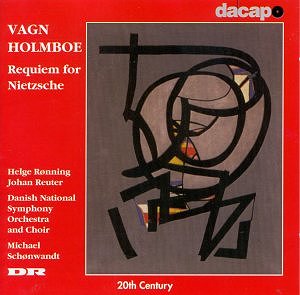There has been a very long wait for the first recording
of this almost fabled work. The release of this disc is to be greeted
in much the same way that we would welcome world premiere recordings
of John Foulds' War Requiem, Havergal Brian's Prometheus Unbound,
Malcolm Williamson's Mass of Christ the King or Peter Racine
Fricker's A Vision of Judgement. That said this may not be quite
the experience you expected. If you know your Holmboe from the middle
period symphonies, from the chamber concertos or from the Preludes,
the Requiem may come as a shocking reveille.
As I have hinted already, this Requiem deploys
Holmboe's ultima thule in terms of style and expression. In short
it is Holmboe's most avant-garde work. It has more in common with those
enigmatic and austere statements Monolith and Epilog (and
perhaps with the piano work Suono da Bardo) than with the first
six symphonies. In the Basel section (from 08.00 onwards)
of the long first track the choir whispers, shouts, wails and caterwauls
in a mosaic of chaos in motion.
Holmboe is not the only composer to have used a major
choral work to rebel against the orthodox envelope. Holst, in his Hymn
of Jesus, also used choir techniques and effects, including sprechgesang,
he was to use nowhere else except perhaps in the Choral Symphony.
This work is in five parts each of which is allotted
a single track. It is not at all typical of DaCapo that they fail to
track the multiple episodes within each of the five parts. It would
certainly have aided appreciation if they had.
The trajectory of the work proceeds from temptation
to bliss, via madness and finally (and most improbably for Nietzsche
of all people) rest with God. The opening takes the form of a cantilena
by the solo cello. This speaks with as much compassion as the early
sections of Tippett's A Child of Our Time. The cello ushers in
and then accompanies the chorus who sing quietly in not quite awe; not
quite tenderness.
In Part Two there are three episodes: Vennerne;
Sils Maria; Den Tredie Fristelse. The Third Part is spoken
and acted. Acrid atmosphere and corrosive horror are abroad with the
Dies Irae never that far distant. Once again the pages of this
score carry the imprint of the sixties Polish school - Penderecki and
Lutosławski. Words are spat out by
the choir like a spray of acid. The mantra-like assault of the 'He would
no longer Nietzsche be!' portray the hero's breakdown - the descent
into madness and negation.
The documentation is an exemplar. Full background is
given. The sung texts are given side by side: the original Danish with
English and German.
The notes are by Paul Rapoport who has, since the 1970s,
written about Holmboe and others consigned to the periphery by orthodoxy.
He tells us that this Requiem shares a similar audacious intensity
with a major choral work Moses by fellow Dane Herman D Koppel
(1908-98). I must track that down.
This is a work that has about it the eschatological
visionary values of Franz Schmidt's Book of the Seven Seals,
Hilding Rosenberg's Fourth Symphony Johannes Uppenbarelse
and Martinů's Epic of Gilgamesh.
Listen for livid anger, for the vituperative bile of
psychotic madness and for the quietness of an inward voice often articulated
by the chorus.
Rob Barnett


